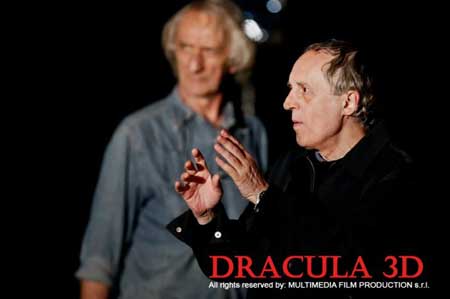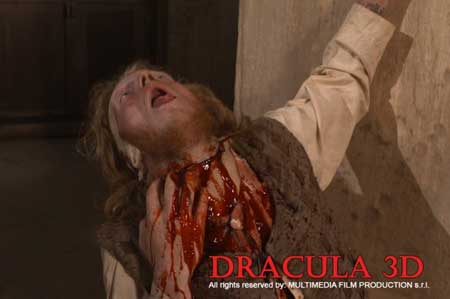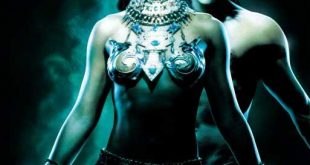The tale begins with Jonathan Harker, journeying by train and carriage from England to Count Dracula’s crumbling, remote castle situated in the Carpathian Mountains on the border of Transylvania. The purpose of his mission is to catalogue the big library of Dracula. At first enticed by Dracula’s gracious manner, Harker soon discovers that he has become a prisoner in the castle. He also begins to see disquieting facets of Dracula’s nocturnal life. One night while searching for a way out of the castle, and against Dracula’s strict admonition not to venture outside his room at night, Harker falls under the spell of three wanton female vampires, the Brides of Dracula.
REVIEW:
Dario Argento is a living legend. Not only is he of the few directors to mold horror into an art form, he’s influenced film makers across the board, from Quentin Tarantino to “The Nightmare Before Christmas” mastermind Henry Selick. Unless you’re an obsessive Jennifer Connelly fan who knows that her first starring role was in “Phenomena” (I watched it under the title “Creepers”), he is probably known best for 1977’s “Suspiria.” Rightfully so in this humble opinion, as his surreal and shocking foray into witchcraft remains one of my favorites in any genre.
Argento’s work has received criticism since he’s shifted into old age and become more “Asia’s Dad” than brilliant auteur. Though his recent offerings don’t possess the same piss and vinegar as earlier efforts, the allegations that he no longer cares for his craft are rather unfair. “Do You Like Hitchcock?” from 2005 is a delightful (if slight) homage to Alfred’s style, and “Jennifer,” his contribution to the Showtime series “Masters of Horror,” is a bizarre treat.
With “Dracula 3-D,” Argento may be asking his adorers to stretch their faith in his passion further than before, but he needn’t go to the trouble here. His rendition of Bram Stoker’s oft-told 1897 tale, though not without a shopping list of flaws, is a batshit bonkers stew of Hammer Films’ low-tech vision, wild theatrics and charmingly cheesy digital effects that would feel perfectly at home in a SyFy Channel Original. I may lose a few cool points with fellow reviewers (Black Saint already thinks I’m useless for enjoying “Apollo 18”), but this is an unabashed safari through the classic with a wizened tour guide completely off his meds.
Unlike nearly every other interpretation, we do not begin with Jonathan Harker on his journey to Transylvania from England, but with an attack on comely villager Tonja (Miriam Giovanelli) as she is returning home from an evening tryst. Leave it to Argento to kick off his take on cherished Victorian fiction with a nude scene approaching p*rnography followed by violent death. It also affords a glimpse into the possible former life of a “Bride,” Tonja serving later as a composite of all three. (Fun Fact: The phrase “Brides of Dracula” never appears in the book. They are referred to merely as “the sisters.”)
Unax Ugalde portrays the ill-fated Harker with the naivete we’ve come to expect from the rarely embellished role. Has this character ever been presented as more than a bland bag of blood? After being welcomed by family friend Lucy (Asia Argento, pushing 40 and still gorgeous beyond words), he makes his way to Dracula’s castle. That night, a group of concerned citizens exhumes Tonja’s corpse to ensure she’s perished, only to be assaulted by Giovanni Franzoni’s Renfield. The henchman is captured after a visceral struggle, but Tonja slips from her grave unnoticed. Computer-generated gore is usually despised by yours truly but fits the 3-D presentation here, especially given the wonky antics to follow.
Harker meets Dracula over dinner upon his arrival, prompting my favorite moment of any adaptation, the answer to the query “But how’s the dude who plays the Count?” Thomas Kretschmann is an actor with a mountainous amount of genre credits to his name, including entries in the “Blade”, “Resident Evil” and “Hostel” franchises. He cuts an imposing figure as the titular antagonist, and manages to make the overwrought moments (of which there are plenty) watchable. It’s no wonder he’s been a “Creepy German” go-to guy for years.
Employed to organize and catalog the dusty books piled in the estate’s vast library, Harker is soon bitten and enslaved by Dracula after nearly becoming a midnight snack for Tonja. The Count then drops in on the incarcerated Renfield and in an original twist, spares his life. This was admittedly a bit disappointing, as with even some of the weaker manifestations (looking in your general direction, 1979 Frank Langella version), this moment is almost always a highlight.
The action takes place entirely in the Transylvanian village and never ventures to the United Kingdom, mostly due to obvious budgetary constraints. This is accomplished easily enough by bringing Mina Harker (Marta Gastini) there on a holiday to see her husband, where she is delayed from her trip to the castle by an ill Lucy. Recently visited by the Count, Lucy dies and leaves a suspicious Mina to contact Van Helsing, portrayed by none other than icon Rutger Hauer.
It pains me to say this, but in a piece filled with passable-to-middling performances, Hauer is the obvious weak link. He has never looked older or more fatigued, leading one to wonder if he was suffering from a malady during filming, or he just didn’t give a rat’s ass about anything happening around him. I’m going to give him the benefit of the doubt, which makes me sincerely worried for the man’s health. Either way, something is decidedly amiss here.
The latter half adheres faithfully to the novel’s doomed love story, despite a significant departure in Mina’s motivations during the cemetery finale. The largest variation from the original text, however, lies in the sheer insanity of Dracula’s shape-shifting transformations and the random array of creatures he becomes throughout the film’s course. Though an owl or swarm of flies is feasible, the guise under which our beloved baddie arrives at Lucy’s to claim Mina as his own is so mind-blowing, so inexplicable, it touches genius. If you don’t rewind to guarantee that your eyes actually saw what you think they did, you my friend are incapable of surprise.
Taken with a grain of salt, “Dracula 3-D” is 110 minutes of gaudy tomfoolery that seems to work almost in spite of itself. The most amusing aspect may be that it premiered as an official selection at the Cannes Film Festival the year of its release, surely an iconoclastic entry for the venue. Hell, it was probably the most fun anyone had there all week.
Film Review: Dracula 3D (2012)
 Horror News | HNN Official Site | Horror Movies,Trailers, Reviews
Horror News | HNN Official Site | Horror Movies,Trailers, Reviews










![True_Blood_Jessica_Fangs_by_Morgadu[1]](https://horrornews.net/wp-content/uploads/2011/11/True_Blood_Jessica_Fangs_by_Morgadu1-310x165.jpg)



